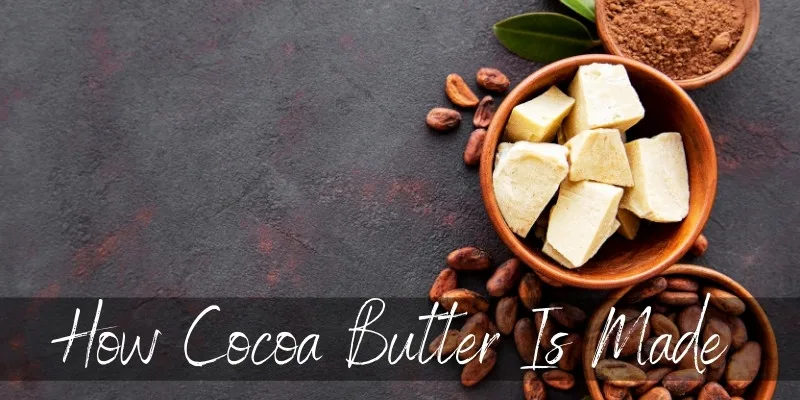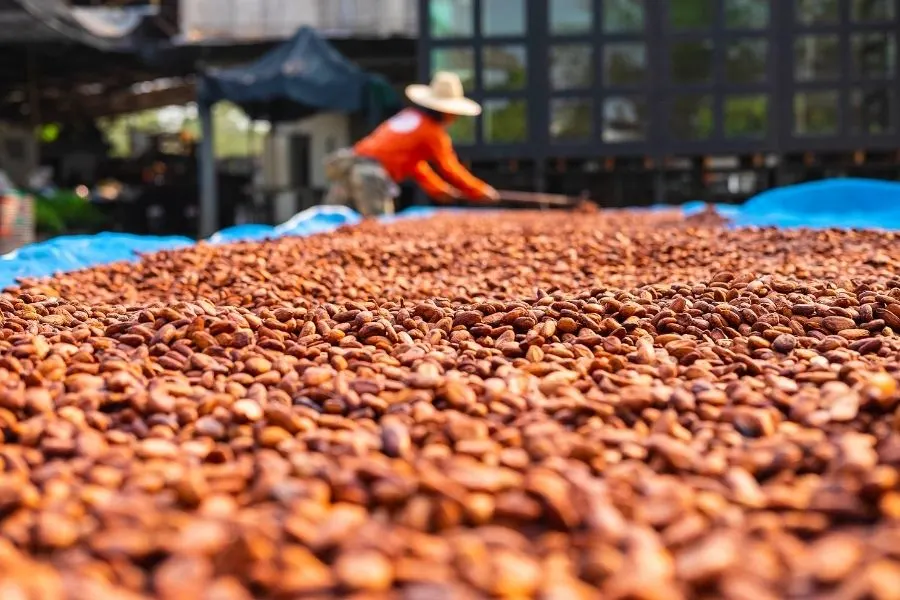Are you in love with chocolate ? Then you might just be in love with cocoa butter as well !
Yes, one of the most amazing sweets on this earth lends half its flavor to cocoa butter. It’s the butter that makes chocolate so melty and creamy and oh so delicious.
But the process of obtaining cocoa butter isn’t as easy as some might think. There’s a lot of hard work that goes into making just a few grams of the stuff.
Today we’re taking a look at exactly how cocoa butter is made, so we can really appreciate every little bit of chocolate in our lives.
And it’s not just for chocolate, you know. Cocoa butter is used in all kinds of products too !

How cocoa butter is made
The process of extracting cocoa butter is simple, but requires a lot of patience.
You need to harvest cocoa pods and remove the seeds. Next, you need to dry the cocoa beans.
Some manufacturers prefer to roast or ferment the cocoa beans before drying them.
The final step is pressing the bean to separate the cocoa butter.
There is a lot of hype about cocoa butter, especially as a skincare product. You must understand how cocoa butter is made before you attempt to make it at home.
There are several steps in the extraction of cocoa butter done by manufacturers. You should try to buy cold-pressed cocoa butter if possible, especially if you’re looking for more nutrients.
And yes, cocoa butter is vegan, despite having the name ‘butter’ plastered onto it.
Read Also:Can You Freeze Tiramisu ?
What cocoa butter actually is
Cocoa butter comes from the same plant as cocoa powder. On average, cocoa beans are 50-54% made up of cocoa butter. The remainder goes into the production of cocoa powder.
The extraction process separates the butter from the powder. Cocoa butter comes from the cocoa plants, which are indigenous to West Africa.
The cocoa plant produces a cocoa pod that is full of cocoa beans on the inside. One pod contains at least 40 cocoa beans, with some containing up to 60 cocoa beans. The pods are ready for harvest when they turn a deep shade of red.
Making cocoa butter – step by step
There are various methods of extracting cocoa butter. The edible kind includes a fermentation process that produces cocoa butter worthy of making high-quality chocolate.
The other methods are similar to the extraction process of edible cocoa butter, but the most famous one is the cold pressed cocoa butter that yields raw cacao butter.
There are four significant steps in the extraction of cocoa butter. The steps include harvesting the beans, drying, fermentation, and cold pressing.
Step 1 – extracting cocoa beans from pods
The process of extracting cocoa beans can be time-consuming for beginners. Ripe cocoa pods are red, and the cocoa beans inside will be white.
The pods are split open to remove the beans for drying. Some companies opt to dry the pods and extract the beans later, but it takes longer to dry them.
Some cocoa beans are attached, and they are separated when being extracted from the pods. Removing the beans requires a blunt knife to remove the beans gently without splitting them. It is tedious, but it is worth it to get the beans out whole.

If you’re trying to do this at home from scratch, you will definitely need someone to help you as this is very time consuming, even for skilled workers.
Step 2 – fermenting the cocoa beans
The purpose of fermentation is to intensify the flavor of the beans. It takes a short while to ferment the cocoa beans.
The process improves the quality of the beans and the quality of the products extracted from them.
Some manufacturers prefer roasting the beans instead of the fermentation process. The results are similar no matter the procedure manufacturers use.
In terms of how to actually ferment cocoa beans, you need to pile all the beans in one spot, preferably a box or something to hold them all together in a warm place. Make sure the box has small hols on the bottom, and is raised off the ground.
As the beans ferment, juices will drip and if they pool at the bottom the beans will rot.
Once you’ve got the beans in one spot, cover them and stir them every two days, changing the box with each stir. This needs to be done for about 10 days if you’re using large, full boxes.
Step 3 – drying the cocoa beans
The step removes any excess moisture from the cocoa beans. Lower moisture content ensures that companies get the purest form of cocoa butter.
Some companies use solar panels or dry ovens for the drying process, while small businesses may simply sundry the cocoa beans.
The process of drying the beans will depend on the quantity you are drying. Sun-drying can take a few days before the beans have extremely low moisture content.
The beans are flipped during the process to ensure they dry evenly and prevent moisture accumulation on the rack.

Step 4 – grinding and pressing the beans
The beans are finely ground so they can be pressed, in order to obtain cocoa butter.
And now comes the part where companies differ.
On one hand, you can warm the ground beans and press them warm. This makes cocoa butter easier to extract, but does not yield raw cacao butter. This is the most common method.
On the other hand, you can cold press the ground beans, meaning they won’t be warmed at all and the resulting butter is raw cacao butter.
There are two ways that the cold pressing process can go. Some brands prefer to press the whole bean to extract cocoa butter. Other companies prefer to grind the beans into a pulp then press the pulp to extract the oil.
Both methods are excellent because they do not involve heat in the extraction process. The grinding step ensures the maximum extraction of cocoa butter from the cocoa beans.
Is cold pressing the better method ?
The cold pressing method ensures that you get the purest form of cocoa butter. Other butter extraction methods include the application of heat and the use of an alkaline solution to separate the fat from the beans.
This is in regard to the Dutch processing model, where the beans are washed in an alkaline solution of potassium carbonate. This gives the resulting cocoa powder its reddish tinge, and it does another thing.
If you’re a baker, or at least moderately interested in obtaining great chocolate cake, you will need to know that Dutch process cocoa is neutral, meaning it will go with baking powder.
It’s not better or worse than cacao (raw), it’s simply different and something that may make your cake that much better.
In regards to flavor, this is very personal so we’re not going to vote on which pressing method yields the best cocoa butter.
What can you do with cocoa butter ?
It is best to buy edible cocoa butter because it has a lot of uses. Edible cocoa butter is mostly used in preparing chocolate, but it’s not limited to that.
You can use it to make skincare products, especially lip balms because people frequently lick their lips.
Or, you can always buy cocoa butter for topical application when you want to make shampoos, conditioners, lotions, and creams.
Keep in mind that cocoa butter has no caffeine in it, the majority of caffeine remains within the solids (cocoa powder). This means you can safely use cocoa butter for foods meant for children or elderly people.
The bottom line is you should try to find the purest form of cocoa butter within your budget. Keep in mind that cold pressed or raw cacao butter is always more expensive than regular cocoa butter.
Can you make homemade cocoa butter ?
Yes, you can make cocoa butter at home but you need the right equipment and tools. The process is similar to what companies use, and you can follow the steps we discussed above.
The cocoa butter you’re making at home is most likely going to be raw cacao butter, so it may taste a little different than cocoa butter.
You can use a grinder to grind the beans before pressing the pulp to extract the butter. You will need to strain the butter to remove any particles before storing it in a jar.
Keep in mind that the butter will have a yellowish color after the extraction, don’t expect it to be brown.
The boiling point of cocoa butter is low, but it will be solid during the cold seasons. You can store it in the form of bars if you live in a cold area. Otherwise, please keep it in a jar in case it melts during the warm season.
How long does cocoa butter last ?
Pure cocoa butter can last for 1.5-2 years without going rancid. This butter is very stable, and it solidifies at room temp.
Of course, you can keep it in a colder place like a pantry or the fridge, and it will keep very long.
It contains natural fatty acids that keep it is usable for a long time. You can store the butter in a cool and dry place after the extraction process.
We’ve covered how to store cocoa butter in this article, and you’ll also find out how you can make it last longer.
Read Also:Should Cupcakes Be Cold Before Icing ?
Final thoughts
Cocoa butter has several culinary and beauty uses. You can use cocoa butter for desserts or skincare, and both will only make you want even more chocolate.
Understanding how cocoa butter is made can help you when you decide to extract some as a DIY project. A time consuming one, but delicious.
Cocoa butter is becoming more and more expensive because of the demand all over the world. You don’t have to buy the butter when you live in an area where cocoa beans are readily available.
Extract the butter at home and whip up a highly moisturizing cream in the comfort of your home.
In the end, you will have high-quality cocoa butter at an affordable price. Therefore, make your cocoa butter and enjoy having high-end butter for a fraction of the cost.

